I believe that breeding fish is one of the most rewarding experiences in the hobby of fish keeping. In this guide on the It’s amazing to see the growth and development of fish from the egg or fry stage to adulthood. Breeding fish is also a great way to increase the population of your favorite fish and can be a valuable learning experience for aquarists of all levels. In this blog post, I’ll share some of the easiest fish to breed in a community tank, including livebearing fish, egg-laying fish, and cichlids. I’ll also provide some tips for successfully breeding fish in your community tank.
While there are many benefits to breeding fish in a community tank. One of the main benefits is the ability to increase the population of your favorite fish species. This is especially important for rare or endangered species that may be difficult to find in pet stores. Breeding fish can also be a great way to observe interesting breeding behaviors and learn more about the natural reproductive process of fish. Additionally, breeding fish can be a fun and rewarding experience that can help you grow as a fish keeper. see also 10 easiest and most profitable fish to breed or the most profitable fish to breed
The 9 easiest fish to breed in a community tank are:
- Guppies
- Mollies
- Swordtails
- Platies
- Cory Catfish
- Bristlenose Plecos
- Shrimp
- Convict cichlids
- Firemouth cichlids

Easiest Live Bearing Fish to breed in a community tank
Guppies:
Guppies are a great choice for beginner breeders due to their hardiness and ease of breeding. They are also available in a variety of colors and patterns, making them a popular choice among fish keepers. Guppies give birth to fry approximately once a month, and the fry can be separated from the adults at around 4-6 weeks of age.

To breed guppies, it’s important to have a male and several females in the tank. Guppies are known for their prolific breeding and will give birth to fry every 4-6 weeks. The gestation period for guppies is around 3-4 weeks, and once the fry are born, they can be separated from the adults and placed in a separate tank or breeding net.
When caring for guppy fry, it’s important to feed them small amounts of food several times a day. Baby brine shrimp, crushed flakes, or commercial fry food can all be used to feed the fry. It’s also important to maintain clean water conditions and ensure that the temperature and pH are appropriate for the fry’s needs.
Platies:
Platies are another popular livebearing fish for breeding in a community tank. They are hardy and easy to care for, making them a great choice for beginners. Platies give birth to fry approximately every 4-6 weeks, and the fry can be separated from the adults at around 3-4 weeks of age.
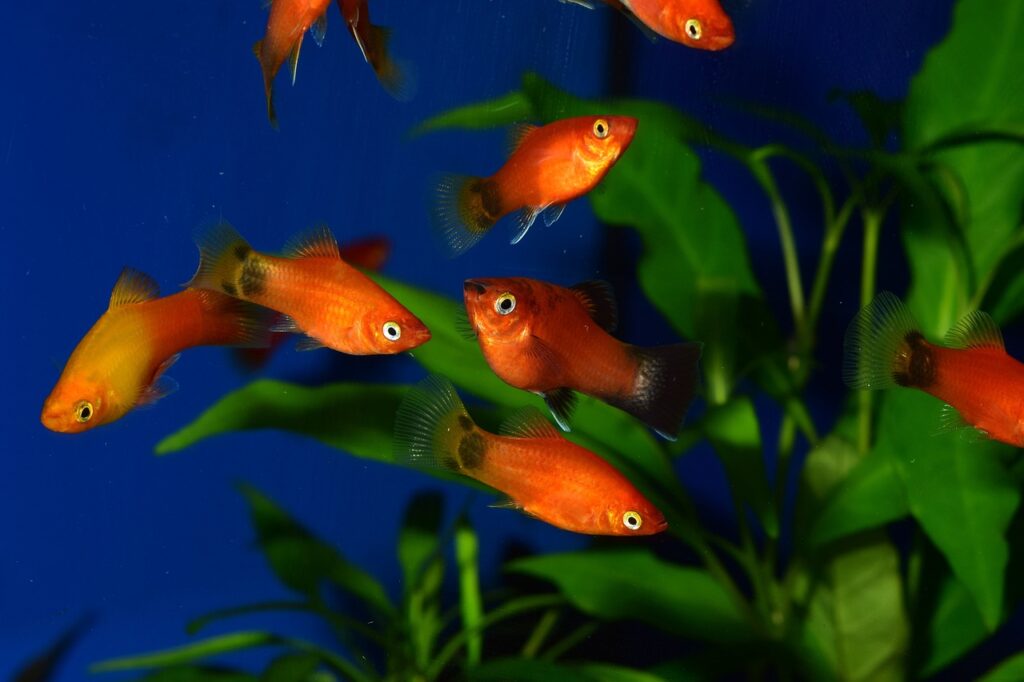
Breeding platies is similar to breeding guppies, as they are both livebearing fish. It’s important to have a male and several females in the tank to ensure successful breeding. Platies will give birth to fry every 4-6 weeks, and the gestation period is around 4 weeks.
When caring for platy fry, it’s important to feed them small amounts of food several times a day. Baby brine shrimp, crushed flakes, or commercial fry food can all be used to feed the fry. It’s also important to maintain clean water conditions and ensure that the temperature and pH are appropriate for the fry’s needs.
Mollies:
Mollies are a bit more challenging to breed than guppies and platies, but they are still relatively easy compared to other fish species. Mollies give birth to larger fry than guppies and platies, and the fry can be separated from the adults at around 4-6 weeks of age.
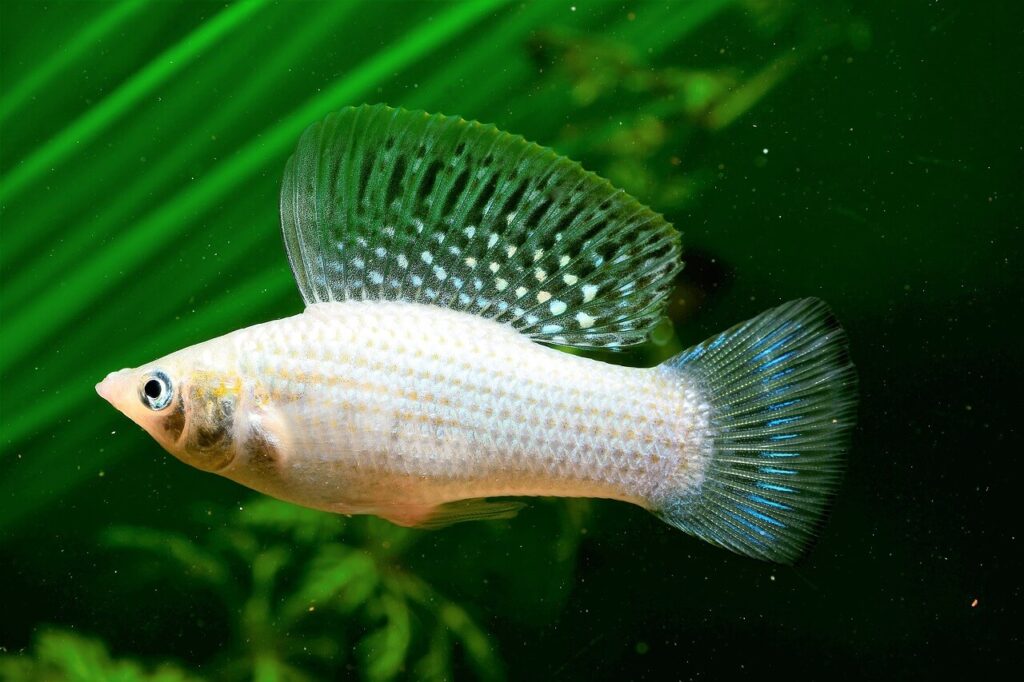
Breeding mollies is a bit more challenging than breeding guppies and platies, as they require specific water conditions and diet to breed successfully. It’s important to have a male and several females in the tank, and the water should be slightly brackish to encourage breeding. Mollies will give birth to larger fry than guppies and platies, and the gestation period is around 4-6 weeks.
When caring for mollies fry, it’s important to feed them small amounts of food several times a day. Baby brine shrimp, crushed flakes, or commercial fry food can all be used to feed the fry. It’s also important to maintain clean water conditions and ensure that the temperature and pH are appropriate for the fry’s needs.
Swordtails:
Swordtails are another popular livebearing fish for breeding in a community tank. They are hardy and active, making them a great addition to any aquarium. Swordtails give birth to fry approximately every 4-6 weeks, and the fry can be separated from the adults at around 3-4 weeks of age.

Breeding swordtails is similar to breeding platies and guppies. It’s important to have a male and several females in the tank to ensure successful breeding. Swordtails will give birth to fry every 4-6 weeks, and the gestation period is around 3-4 weeks.
When caring for swordtail fry, it’s important to feed them small amounts of food several times a day. Baby brine shrimp, crushed flakes, or commercial fry food can all be used to feed the fry. It’s also important to maintain clean water conditions and ensure that the temperature and pH are appropriate for the fry’s needs.
Overall, it’s important to research and understand the specific needs of each livebearing fish species before attempting to breed them. Proper care and attention will ensure successful breeding and healthy fry for the easiest fish to breed in a community tank
The Easiest Egg-laying fish to breed in community Aquarium
As a fish expert with years of experience, I can tell you that egg-laying fish require different breeding and care techniques than livebearing fish. Some examples of egg-laying fish include cory cats and bristlenose plecos.
When breeding egg-laying fish, it’s important to create the right environment for the fish to lay their eggs. This may involve creating hiding spots with plants or rocks, as well as providing the right water conditions, such as a specific pH level and temperature.
Cory Catfish
Cory cats, for example, are known for their unique breeding behavior. To breed cory cats, it’s important to have a group of at least six fish, with a 1:1 male-to-female ratio. The breeding tank should have a layer of fine gravel or sand at the bottom, and the water should be slightly acidic with a pH between 6.5 and 7.0.

Once the cory cats have laid their eggs, it’s important to remove the adults from the tank, as they may eat the eggs. The eggs will hatch in around 3-5 days, and the fry can be fed a diet of baby brine shrimp or commercial fry food.
Bristlenose Plecos
Bristlenose plecos also require specific breeding conditions. It’s important to have a breeding pair in the tank, with plenty of hiding spots and plants. The water should be slightly acidic with a pH between 6.5 and 7.5. Once the plecos have laid their eggs, they will guard them until they hatch, which typically takes around 5-10 days.

When caring for bristlenose pleco fry, it’s important to feed them a diet of algae wafers, vegetables, and commercial fry food. It’s also important to maintain clean water conditions and ensure that the temperature and pH are appropriate for the fry’s needs.
When the eggs hatch, the fry will feed off their egg sacs for the first few days before they can be fed with newly hatched brine shrimp or commercial fry food. It’s important to ensure that the fry are receiving adequate nutrition and that the water quality is maintained to prevent any diseases or infections.
Additionally, egg-laying fish can produce a large number of eggs at once, which can be challenging to raise. It’s important to have a plan for what you will do with the fry, as they may require separate tanks or a larger tank to grow in.
In conclusion, The easiest fish to breed in a community tank for egg-laying fish require specific breeding and care techniques to ensure successful breeding and healthy fry. It’s important to research and understand the specific needs of each species before attempting to breed them.
Convict Cichlids
Cichlids are another popular type of fish that can be bred in a community tank. However, unlike livebearing fish and some egg-laying fish, cichlids are known for their aggressive behavior and territorial nature. This means that breeding cichlids can be challenging, and it’s important to research the specific species of cichlid you want to breed to ensure that they are compatible with other fish in your tank.
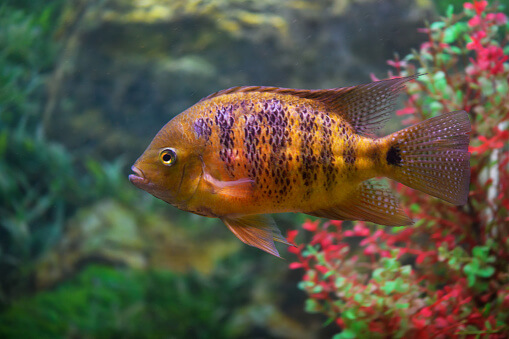
One type of cichlid that is relatively easy to breed is the convict cichlid. To breed convict cichlids, it’s important to have a breeding pair in the tank, with plenty of hiding spots and a flat surface for the female to lay her eggs on. The water should be slightly alkaline with a pH between 7.0 and 8.0.
Once the eggs have been laid, the male will guard them while the female protects the territory. The eggs will hatch in around 2-3 days, and the fry can be fed a diet of newly hatched brine shrimp or commercial fry food.
Firemouth Cichlids
Another type of cichlid that can be bred in a community tank is the Firemouth cichlid while these can be more challenging to breed than convict cichlids, and it’s important to have a larger tank with plenty of space for the fish to swim and establish their territories.
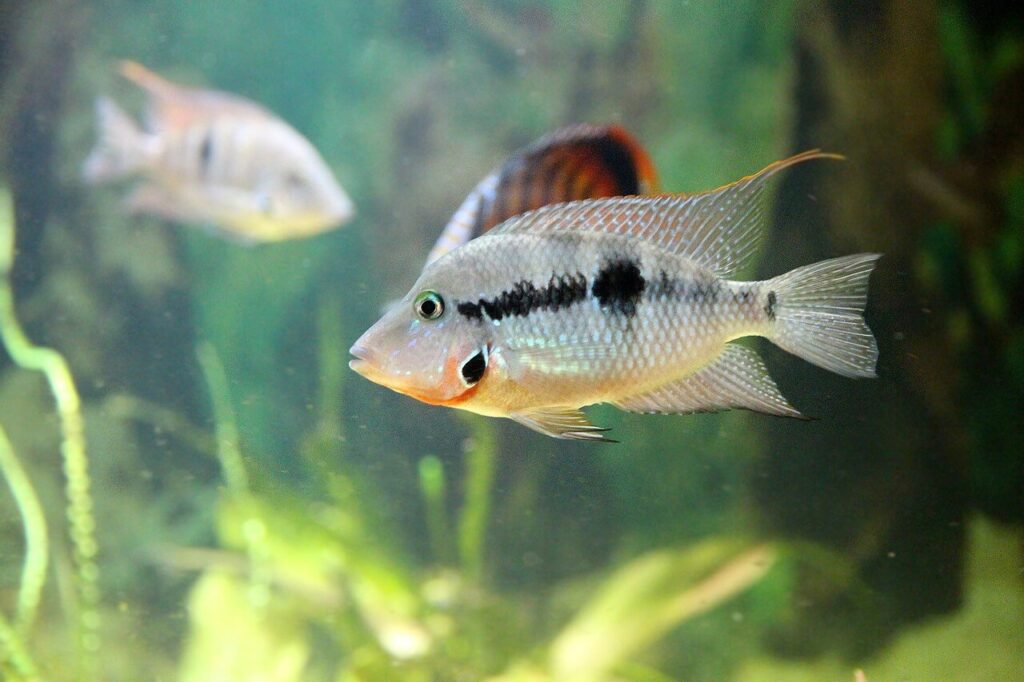
To breed firemouth cichlids, it’s important to have a breeding pair in the tank, with plenty of plants and a flat surface for the female to lay her eggs on. The water should be slightly acidic with a pH between 6.5 and 7.0. Once the eggs have been laid, the parents will guard them until they hatch in around 2-3 days.
Caring for cichlid fry can be challenging, as they require specific water conditions and a balanced diet. It’s important to research the specific needs of the species you are breeding and provide them with the appropriate food and water parameters.
In conclusion, cichlids can be bred in a community tank, but it’s important to research the specific species you want to breed and ensure that they are compatible with other fish in your tank. With the right environment and care, cichlids can be a rewarding fish to breed and observe their unique breeding behavior.
Shrimp
Freshwater shrimp are a great addition to any community tank. Not only are they fascinating to watch, but they can also help to keep your tank clean by eating leftover food and other debris. If you’re interested in breeding freshwater shrimp, there are a few things you should know.
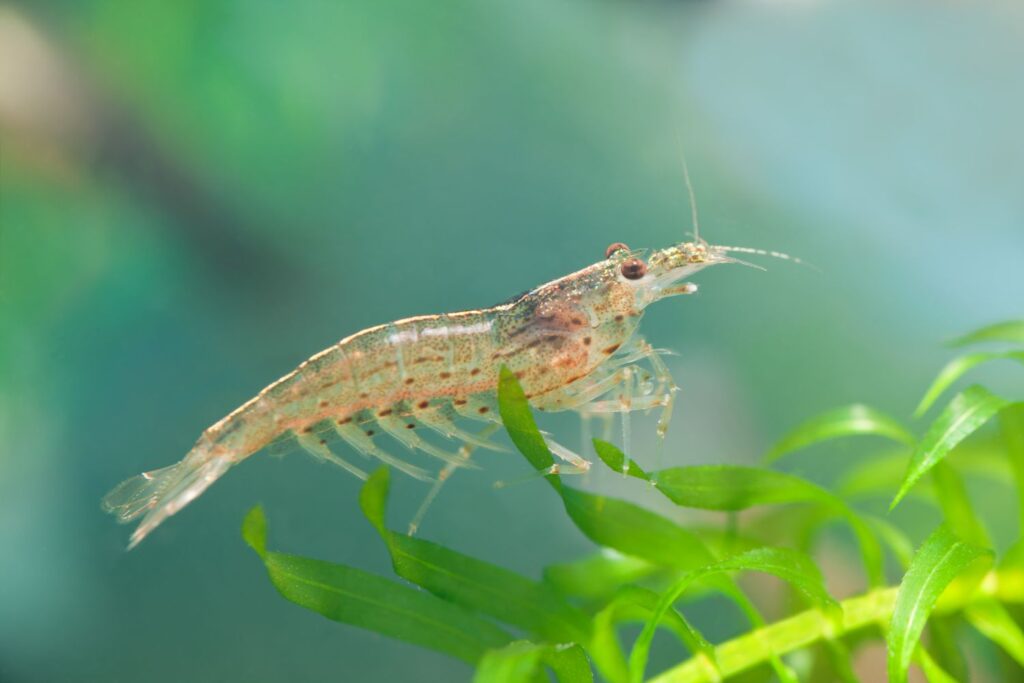
First, it’s important to choose the right species of shrimp. Some of the most popular species for breeding include cherry shrimp, amano shrimp, and crystal red shrimp. These species are all relatively easy to care for and breed, making them great choices for beginners.
To breed freshwater shrimp, you’ll need a well-established tank with plenty of hiding places and plants for the shrimp to hide and lay their eggs. It’s also important to keep the water parameters stable and clean, as shrimp can be sensitive to changes in water quality.
Once your shrimp have bred, the female will carry the eggs until they hatch. Depending on the species, this can take anywhere from a few weeks to a couple of months. When the eggs hatch, the young shrimp (known as “shrimp fry”) will be very small and vulnerable. It’s important to keep them well-fed with specialized shrimp food or finely crushed fish food.
Overall, breeding freshwater shrimp can be a rewarding experience for any aquarium hobbyist. With the right species, setup, and care, you can enjoy watching your shrimp multiply and thrive in your community tank.
Tips for breeding fish in an community tank
1. Choose the right species
When choosing a fish to breed, it’s important to do your research and choose a species that is known to be relatively easy to breed in a home aquarium. Some species require specific conditions or care to breed successfully, so it’s important to choose a species that fits your experience level and the equipment you have available. For example, livebearing fish like guppies and platies are relatively easy to breed, as they give birth to live fry instead of laying eggs. On the other hand, egg-laying fish like cory cats and bristlenose plecos require a bit more effort and attention to breed successfully.
2. Create the right environment
Each species of fish has different environmental requirements for breeding. To encourage breeding behavior, it’s important to provide the right water parameters, temperature, and other conditions. For example, some fish require soft, acidic water to breed, while others prefer harder, more alkaline water. It’s important to research the specific requirements of your chosen species and create an environment that encourages breeding behavior.
3. Provide the right food:
Fish require specific types of food to encourage breeding behavior and support the growth of the fry. For example, many species of egg-laying fish require live or frozen food to trigger breeding behavior. It’s important to research and provide the right food for your specific species to encourage breeding and support the growth of the fry.
4. Keep the tank clean:
A clean tank is important for the health and wellbeing of your fish, and it’s especially important when breeding. Clean water helps to keep the fish healthy and can also encourage breeding behavior. It’s important to maintain a regular cleaning schedule and perform regular water changes to keep the water clean and healthy for your fish.
5. Be patient:
Breeding fish can take time and may not always be successful on the first attempt. It’s important to be patient and allow the fish to establish their breeding behavior over time. It’s also important to be prepared for the possibility of a failed breeding attempt and to have a plan in place for what to do with the eggs or fry if this happens. With patience and persistence, you can increase your chances of success and enjoy the rewards of breeding your own fish in your home aquarium.
What are some of the easiest fish to breed in a community aquarium?
Some of the easiest fish to breed in a community aquarium include livebearing fish such as guppies, platies, and mollies, as well as egg-laying fish such as cory cats and bristlenose plecos.
What conditions are necessary for breeding livebearing fish in a community aquarium?
Livebearing fish generally require a relatively stable environment with a temperature around 75-80 degrees Fahrenheit and a pH between 7.0 and 8.0. They also need plenty of hiding places and a healthy, varied diet.
How do you breed egg-laying fish like cory cats and bristlenose plecos in a community aquarium?
Breeding egg-laying fish requires careful attention to water quality and tank conditions. It’s important to provide a suitable breeding environment, including plenty of hiding places, clean water, and the right food. It’s also important to monitor the fish closely and provide a separate breeding tank or breeding cave to encourage spawning.
What types of food should you provide to encourage breeding behavior in egg-laying fish?
Many egg-laying fish require live or frozen food to trigger breeding behavior. This can include live or frozen brine shrimp, bloodworms, and other small, protein-rich foods. It’s important to research and provide the right food for your specific species to encourage breeding and support the growth of the fry.
How long does it usually take for fish to breed in a community aquarium?
The time it takes for fish to breed in a community aquarium can vary depending on the species, the environment, and other factors. Generally, it can take a few weeks or longer for fish to establish breeding behavior and produce viable eggs or fry. It’s important to be patient and allow the fish to establish their breeding behavior over time.
What fish can you breed in a community tank?
In a community tank, you can breed a variety of fish that are peaceful and compatible with each other, such as tetras, guppies, mollies, barbs, danios, rasboras, and gouramis. Some other species that can be bred in a community tank include cichlids, livebearers, rainbowfish, plecos, and catfish. It is important to research the fish you plan to add to your tank and make sure they will be compatible with each other. Additionally, you should ensure that the tank is correctly set up and maintained to provide the best possible environment for the fish.
Conclusion
In conclusion, breeding fish in a community aquarium can be a rewarding and exciting hobby. With the right conditions, food, and attention, it’s possible to successfully breed a variety of fish species and observe their interesting behaviors. Whether you choose livebearing fish or egg-laying fish, it’s important to research the specific requirements of each species and provide a suitable environment to encourage breeding. By following these tips and being patient, you can enjoy the unique experience of watching your fish breed and raise their young in your own home aquarium.











